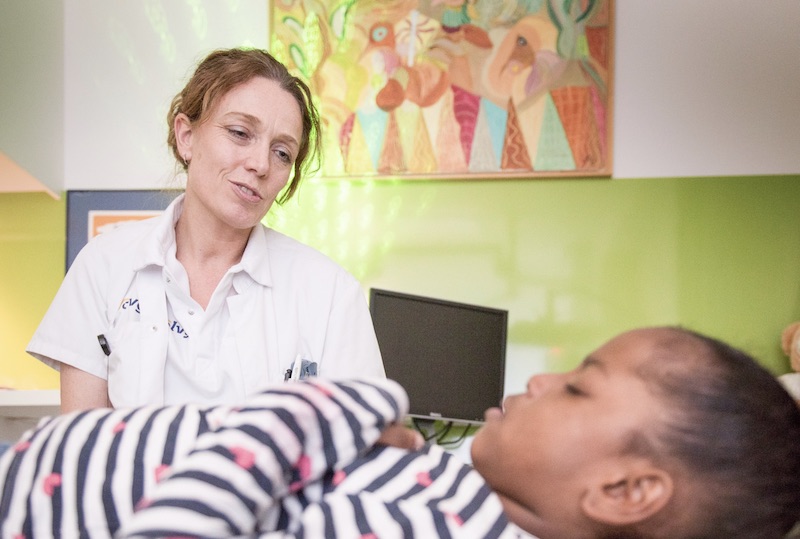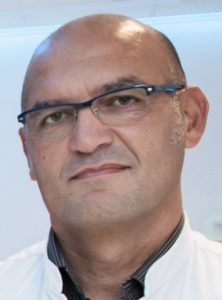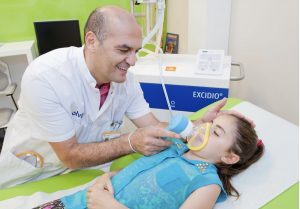
Fear and pain management in children has been high on the agenda at the Amsterdam OLVG for five years now. We speak with pediatrician Şükrü Genco and nursing specialist Linda Schuiten. Both have the mission to put the subject on the map nationwide. “The need for an optimal approach to fear and pain management in children is immense”.

In 2013, OLVG was the first hospital to offer nitrous oxide for the treatment of children in the Emergency Department. It was part of a new approach to combat anxiety and pain in children. This was based on the national guideline of the Central Guidance Organ (CBO) that the practitioner ‘must do everything in his power to prevent a child from experiencing fear or pain’. In order to eliminate child traumas in hospitals, pediatrician Piet Leroy from Maastricht and Şükrü Genco founded the Children’s Sedation Foundation in 2014 to start initiatives in the field of pain control. Since then, the foundation has provided many training courses in OLVG for practitioners throughout the country.
Şükrü: “Very positive. We can be very proud that we really were able to implement the new approach, together with the Maastricht UMC+. I can only say that the results of the use of nitrous oxide have opened our eyes. As a result, we have come to realise the importance of the setting in which you approach, sedate or calm a child, and the rest has started to roll”.
Linda: “We’re always looking for ways to do even better, and we’re learning all the time”.
Şükrü: “Exactly. We innovate, improve and develop best practices, which then also benefit colleagues in other hospitals. Thinking up, rolling out and sharing something that suits OLVG. We often act as a breeding ground for physicians and nurses who want to give their work extra substance, which leads to the development of new, ambitious methods”.
Şükrü: “After the introduction of nitrous oxide, we started to study both medicinal and non-medical methods. These include: medical hypnosis, intranasal sedation techniques, MRIs with sleep sedation, other medications and focal language. We have also trained a nursing specialist with the focus on children with anxiety and pain, and sedation. By training people internally, the new methods to combat anxiety and pain in children fanned out. OLVG is now the place where practitioners come to do the national training for nitrous oxide. Now we are on the important point of taking the next step with the Netherlands Children’s Sedation Foundation. Professionalization, expansion and fundraising are high on the agenda.
Şükrü: “The foundation has stood up for adequate fear and pain management in children and has been the initiator of the new approach. We bring together professionals – colleagues from OLVG, teachers, people from the Academy, scientists and didactic experts – who are actively involved in sedation in children. Among other things, the foundation provides the nitrous oxide courses at OLVG. The NVK (Dutch Association for Paediatrics) also knows where to find us for questions or issues. From the scientific association we even received a nice subsidy. The fact that the output of our work is noticed, is a source of joy!
Linda: “As a paediatric nurse and supervisor in the paediatric ward, I received training in nitrous oxide myself a few years ago. At that time, distracting, holding or fixing the frightened child were often the only ‘methods’ for treatment. Then I came into contact with the nitrous oxide training. I was enormously impressed by its positive effect on anxious children. After that I immediately started the medical hypnosis training. For some time now I have been involved as a teacher in the Children’s Sedation Foundation”.

Şükrü: “Nitrous oxide is part of the possibilities. You have to pay attention to the whole setting around a child. That means that you don’t put knives in sight, don’t apply bright light, and use breathing and relaxation exercises”.
Linda: “Indeed. On the nitrous oxide course I did not only learn how to administer it, but I also received training in how to supervise the children. Peace and confidence are essential here. Meanwhile, non-pharmacological interventions are an important part of the morning program of the nitrous oxide course. If you know how to make contact with a child, that is already your first gain. It became increasingly clear to me what is involved in fear and pain management. For me this was the reason to go into hypnosis. Medical hypnosis is basically daydreaming with a purpose. Children with, for example, anxiety, chronic abdominal pain or nausea complaints often benefit enormously from it. In fact: there are children who suffer from abdominal pain for years and after six sessions of medical hypnosis they are symptom-free!
Linda: “During the medical hypnosis training I met two nursing specialists, both working on the children’s ward at Maastricht UMC+. Their work inspired me. With the help of the paediatricians in OLVG who considered this job a valuable addition to the department and support by the psychologists, I was given permission to follow the master’s programme. I agreed with the paediatricians that my job serves a clear purpose: to reduce procedural distress in children. Prevention plays a major role in this.”
Şükrü: “We are very happy that we invested in Linda’s position at the time. She is indispensable, not only for paediatricians, but for the entire department, for the A&E department and even for other departments”.
Şükrü: “Instead of traumatizing a child, we need to get it right from the start, both in terms of approach and setting. If you already sense that a certain approach is not going in the right direction, you need to stop (for a while). If that doesn’t happen, the treatment will only become more difficult. That time-out is important.” Linda: “Parents are also important. For example, we want to give children tools to make their bodies soft. A ‘soft’ body feels less pain and stress than a tense body. Parents can practice these techniques together with their children. Parents are very happy with tools; no parent wants their child to be put in a headlock. For example, children who are receiving treatment with growth hormone are the right group to learn medical hypnosis, focus and distraction. Preferably before they start treatment.
Amy Baxter, a pediatrician from Atlanta, has created a kind of schedule in which fear, pain and focus and their effect on stress during procedures are central. As a practitioner, you have to think about all three – per child, individually and for every age. Pediatricians have to look for best practices in addition to their work. My added value is that as a dedicated nurse specialist, four days a week, I can fully focus on the best practice approach and how we can do better.”
Şükrü: “That came about through trial and error. If someone is sedated and then comes to and says things like: ‘The treatment was not too bad, but that bright light, or that sound or that ringing phone brought me out of my trance or was not pleasant’, then you learn from that. You do your best to make the setting for the patient as comfortable, calm, painless and anxiety-free as possible. I also work at the VATAN clinic where we treat many children and mainly perform circumcisions. We have built up a lot of expertise in sedation there. When that big lamp is on, it takes more effort to calm someone down than when the light is dimmed and soft background music is playing. By taking environmental factors into account, a lower dose of the sedative is required, which is administered via an IV, for example. This means that there are fewer side effects, the drug wears off more quickly and the patient wakes up more quickly. We have now reached the point where sedation without these kinds of measures is unthinkable, because it works much less well or not at all.”
Şükrü: “Yes! We are ‘thinking differently’. A good example of this is our separate, child-friendly ER, which our pediatrician Paolo Valerio has worked hard for. It is not normal that we protect children outside the hospital from all kinds of misery and trauma, but that we expose them to bloody faces and drunk and aggressive adults in the ER?! That is also an example of creating a pleasant environment. When a child ends up in the ER, we have to ask ourselves: what is he looking at, what does he see happening around him, what sounds does he hear? We have to put an end to unnecessary fear that such a situation can cause.”
Linda: “I get referrals from all over the country from traumatized children with a fear of needles, often with the reason that the hospital in question does not have laughing gas. But what is actually said is that they do not yet have a focus on anxiety and pain management. There is also a group of children who only need a time-out. Sometimes you can even treat them without laughing gas, purely by guiding them or explaining how anxiety works in their body, and how they can exercise control over it. Children from the age of seven understand that very well. If I think that EMDR treatment is appropriate for a child with a trauma, I approach the psychologist to discuss how we are going to approach that. We have good agreements within the team about the actions that I am allowed to perform. In addition, we get children with an intellectual disability who do not understand that mask with laughing gas. Then you do not fight with that mask because then you miss your goal. Based on the experience of the Kindersedatie foundation, we all – the pediatrician, the nurses and I – started looking for best practice. That’s how we came across dexmedetomidine by means of a nasal spray, a drug that these children benefit from because they fall into a kind of natural non-REM sleep.”
Şükrü: “We really do it together here. The doctors and nurses at the ER are also fully aware of the child-oriented policy.”
Linda: “That even minor interventions can cause stress. You often hear: ‘Oh, you hardly feel such a small prick’, but more and more studies are now showing that the more often something is done against someone’s will or under duress, the more sensitive they become to it. We may have been educated and trained with the idea that ‘that makes you hard’, but the opposite is true. I think that is already a very important message.” Şükrü: “There are enough studies that show that the more exposure to pain there is, the lower the pain threshold becomes and that children experience pain sooner. Studies with brain scans even show that it is not at all harmless if a child is put under stress. It is not without reason that anxiety disorders in adulthood often have their origins in childhood.”
Linda: “And it doesn’t just apply to the children it happens to. We also have examples of traumatised children who saw their little brother or sister being held in a chokehold. It has also become clear how important the right use of words is. Words can have a big impact, especially on a fearful child. It makes a big difference whether you say when applying numbing plasters: ‘I’ll stick two because then the doctor can choose later’, or whether you say: ‘I’ll stick two because if one doesn’t work later, then we still have a spot here…’” Şükrü: “Then we can give two injections… We haven’t all considered how important it is to consciously choose our words. In that context, the ambition arose to offer a course in ‘Focus language for the workplace’.”
Linda: “For everyone in healthcare. It is in the interest of both the patient and the healthcare professional to spread the knowledge about this as widely as possible. Focus language is part of the medical hypnosis training, but not everyone needs to do that training, while everyone should have knowledge of the effect of words. A small example: at OLVG we do brace habituation. Recently I heard a girl at the reception complaining about pain from her brace. The nurse – not yet trained in focus language – responded very sweetly and said: ‘Yes, I understand that. That hurts too.’ To which I said to the girl: ‘But you will notice that it gets better and better every day. And when you leave here on Friday you will be so used to it that it feels much better.’ That girl brightened up completely!
I certainly don’t always say the right thing, but I am increasingly aware of the impact words can have on such a child. The focus language training is intended to make that awareness a reality for everyone. It has to become a kind of second nature.” Şükrü: “The moment healthcare professionals hear and know more about the non-medicinal approach, they turn a hundred and eighty degrees and also see that it can be done much better than how they have ever done it.”
Linda: “The first time I did medical hypnosis on a child with an orthopedic condition, the orthopedist accused me of hocus-pocus practices. The same orthopedist recently sent me an email asking if he could approach me to think about the chronic group and how we can get the pain under control there.”
Şükrü: “It is indeed starting to gain more attention, although some hospitals still think too slowly and in isolation, where it should only be about quality and safety of the patient. Politicians and health insurers should also pay more attention and funding to the child-oriented approach, so that hospitals are more likely to be stimulated to actually provide that care. There is often a will to implement laughing gas, but the proposal is then swept aside because of the cost of the renovation, while it only generates money – in terms of treatment. I really hope that this will change soon so that the entire approach to sedation and how we deal with children becomes common practice. You can’t always do it right for everyone, but if there is just an eye for an optimal approach, the first step has been taken.”
Şükrü: “Certainly! It is the first European congress on pediatric sedation with many important, international speakers who have been active in this field for years. We are very happy that we managed to get them together. During two days, the entire range of both drug and non-drug approaches will be discussed, and that at the highest level. In addition, useful practical sessions will be offered, and there will be hands-on workshops and sessions in which you will sit at the table with the expert who has already performed thousands of sedations in a specific field. A unique opportunity!”